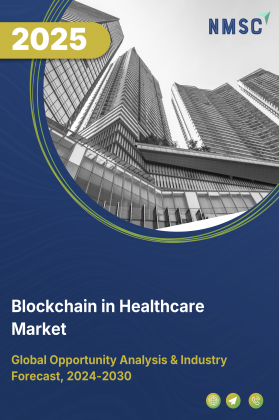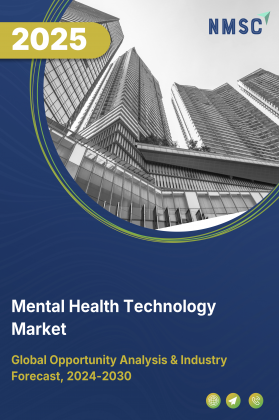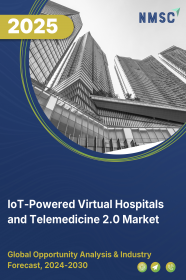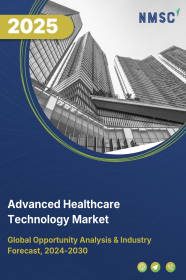
Blockchain in Healthcare Market by Component (Platform, Services), by Type (Permissioned, Consortium, Permissionless, Hybrid), by Deployment Model (On-Premise, Cloud-Hosted, Blockchain-as-a-Service), by Application (Clinical Data Management, Operational Processes, Financial & Administrative), by Business Model (Licensing Fees, Transaction Fees, and Consortium Membership Fees), by End User – Global Opportunity Analysis & Forecast 2024–2030
Industry Overview
The global Blockchain in Healthcare Market size was valued at USD 5.68 billion in 2024 and is predicted to reach USD 8.76 billion by the end of 2025. The industry is predicted to reach USD 76.55 billion by 2030 with a CAGR of 54.3% from 2025-2030.
The market is witnessing significant growth, propelled by the rising need for secure and tamper-proof systems to combat increasing cyber threats. As healthcare remains one of the most targeted sectors for data breaches and ransomware attacks, blockchain's decentralized ledger offers a powerful solution to ensure data integrity and confidentiality. This shift is further supported by evolving regulatory frameworks that require auditable, secure, and interoperable systems, prompting widespread adoption across healthcare institutions.
However, the blockchain in healthcare market growth faces challenges in integrating blockchain with existing legacy systems. Many healthcare providers operate outdated platforms that are not equipped to support decentralized models, leading to concerns around cost, interoperability, and implementation timelines.
Despite these obstacles, the future outlook remains strong, especially with the growing emphasis on patient-centric care. Blockchain empowers patients with greater control over their health data, enabling secure sharing, consent management, and ownership across healthcare providers. This shift is paving the way for innovative solutions such as digital health wallets and consent-based platforms, opening new growth avenues for technology vendors and digital health players alike.
Growing Demand for Data Security Drives Market Growth
Data breaches in healthcare continue to escalate, placing sensitive patient information at significant risk. Blockchain technology addresses this critical issue through its decentralized and tamper-proof ledger, ensuring data integrity and confidentiality. Healthcare has become the most heavily targeted critical sector, with ransomware accounting for roughly 45% of all cyber-incidents and data breaches making up another 28% hospitals alone represent more than half of those events.
At the same time, new EU requirements such as the NIS2 Directive, the European Health Data Space, and the 2025 Action Plan for hospital cybersecurity are compelling providers to implement airtight, auditable protections. These intensifying threats and stricter compliance mandates are prompting healthcare organizations to deploy blockchain’s tamper-resistant ledger fueling strong demand and driving significant expansion in the global market.
Supportive Government Regulations Fuel the Blockchain in Healthcare Growth
Governments and regulatory bodies are increasingly recognizing blockchain as a transformative force in healthcare, introducing policies that promote its integration across systems. The recently adopted European Health Data Space (EHDS) Regulation (EU 2025/327), which came into force on May 2025, establishes an EU-wide legal framework requiring all electronic health record (EHR) systems to implement two harmonised software components, a logging component for immutable audit trails and an interoperability component for seamless, standards-based data exchange.
By mandating tamper-proof, auditable records and cross-border data sharing, the EHDS compels healthcare providers and vendors to integrate distributed-ledger solutions positioning blockchain as the natural technology to meet these requirements and thus fueling substantial growth in the blockchain-in-healthcare market
Rising Concerns Over Counterfeit Drugs and Supply Chain Transparency
The global healthcare sector is increasingly grappling with the threat of counterfeit drugs infiltrating the supply chain a challenge that not only endangers patient lives but also undermines trust in pharmaceutical systems. According to the World Health Organization (WHO), around 1 in 10 medical products in low- and middle-income countries is either substandard or falsified. These counterfeit drugs fail to meet safety standards, leading to ineffective treatments and severe health consequences.
Additionally, traditional supply chain systems are fragmented, with limited real-time visibility and delayed response capabilities in case of recalls. Blockchain technology addresses these issues by creating a decentralized and immutable ledger that records every transaction or movement of a drug across the supply chain. Each participant manufacturers, wholesalers, distributors, pharmacies, and regulators can access a transparent and tamper-proof history of the product. This enables real-time tracking from the point of origin to the point of care, ensuring that only verified and compliant medications reach the patient.
Integration Challenges with Legacy Healthcare Systems Restrain the Market Growth
One of the major hurdles to the widespread adoption of blockchain in healthcare is the difficulty of integrating it with existing legacy systems. Most healthcare institutions rely on outdated electronic health record (EHR) platforms and siloed databases that are not designed to support blockchain-based architectures.
Transitioning to a decentralized data-sharing model requires significant changes in infrastructure, staff training, and compliance procedures. Moreover, interoperability issues, resistance to change, and lack of standardized frameworks further delay implementation. These challenges result in high upfront costs and longer deployment timelines, especially for smaller hospitals and clinics with limited IT budgets.
Patient-Centric Data Control Creates Future Opportunities for the Market
A major growth opportunity for the market lies in the increasing shift toward patient-centric data control. With blockchain’s decentralized and tamper-proof infrastructure, patients can directly manage and share their electronic health records (EHRs), enhancing trust, transparency, and personalized care delivery. This transformation is gaining momentum due to regulatory initiatives like the 21st Century Cures Act’s Final Rule, which mandates the use of APIs and prohibits information blocking.
As a result, by 2024, over three-quarters of U.S. patients were provided online access to their medical records, according to the Assistant Secretary for Technology Policy. This regulatory shift has amplified demand for blockchain-enabled platforms that allow patients to grant, revoke, and track data-sharing permissions in real time. Blockchain’s features such as cryptographic consent management, granular access controls, and immutable audit logs enable the creation of secure and user-controlled digital health environments.
Technologies like personal health wallets, built on blockchain, are emerging as powerful tools that give individuals ownership over their medical history across providers and platforms. As healthcare moves toward a more transparent and patient-driven model, blockchain serves as a critical enabler of secure, interoperable, and consent-based data sharing, opening new revenue streams for health IT vendors, digital health startups, and blockchain solution providers.
Market Segmentation and Scope of the Study
The blockchain in healthcare market report is segmented by component, type, deployment model, application, business model, and end user. On the basis of component, the market is classified into platform and services. Based on type, the market is segmented into permissioned, consortium, permissionless, and hybrid models. By deployment model, the market is categorized into on-premise, cloud-hosted, and blockchain-as-a-service. In terms of application, the market is divided into clinical data management, operational processes, and financial & administrative functions. By business model, the market is segmented into licensing fees, transaction fees, and consortium membership fees. Based on end user, the market includes healthcare providers, life sciences, payers, and patients/consumers.
Geographical Analysis
North America currently leads the global blockchain in healthcare market share, with the U.S. accounting for the majority of deployments. The region’s dominance is underpinned by strict serialization mandates and evolving patient-consent regulations, which have accelerated the adoption of secure, decentralized technologies. Tech giants like Oracle are spearheading innovation introducing privacy-enhanced, verifiable credentials designed for healthcare use cases. These tools enable patient-centric identity management and secure data sharing across institutions, further reinforcing blockchain’s relevance in the region’s healthcare transformation.
Europe is rapidly advancing its blockchain capabilities, driven by strong regulatory backing and cross-border healthcare digitization efforts. The European Blockchain Services Infrastructure (EBSI) has emerged as a foundational framework, connecting all EU member states through a peer-to-peer network that supports secure digital services.
Countries like Germany, Estonia, and the Netherlands are leading pilot initiatives in areas such as electronic health records and pharmaceutical supply chain transparency. With GDPR compliance at its core, Europe’s blockchain push emphasizes both privacy and interoperability—two critical enablers for broader adoption in the healthcare sector.
Asia-Pacific is evolving as the fastest-growing region in the blockchain healthcare space, with nations such as China, India, Australia, and Singapore actively investing in blockchain to tackle challenges related to health data management, insurance fraud, and supply chain traceability.
Australia’s national roadmap has formally recognized healthcare as a priority sector for blockchain deployment, offering clear guidelines for standards-based pilot projects. With strong government support and expanding digital infrastructure, the region is well-positioned to surpass Europe in terms of adoption and scalability by the end of the forecast period.
Rest of the World, including the Middle East, Africa, and Latin America, is also witnessing increasing blockchain activity in healthcare through state-led digital health programs and infrastructure enhancements. A notable example is Dubai’s NABIDH platform, which has integrated millions of patient records across a wide network of healthcare providers, enabling seamless and verifiable health data exchange. These early yet impactful deployments reflect the growing strategic importance of emerging markets in driving the next phase of blockchain-enabled healthcare transformation globally.
Strategic Innovations Adopted by Key Players in the Global Blockchain in Healthcare Industry
The companies are at the forefront of integrating blockchain to revolutionize healthcare operations, with a strong focus on enhancing data security, improving interoperability, and enabling patient-centric care models.
-
Between 2024–2025, IBM expanded blockchain based AI governance and healthcare data integrity use cases via partnerships including Casper Labs to deliver a blockchain powered AI governance layer using watsonx.governance across healthcare and other industries. This move substantially enhance IBM’s brand visibility among healthcare enterprise clients, reinforcing long term potential in regulated industries and AI compliance governance.
-
In April 2025, BurstIQ announced the acquisition of Olive AI’s business intelligence solution, marking a key expansion of its data-driven healthcare portfolio. The acquired platform, now rebranded as the LifeGraph Knowledge Care Optimization module, reinforces BurstIQ’s mission to support healthcare organizations in managing complex data environments while upholding strict privacy and compliance standards. This move enhances the LifeGraph ecosystem, enabling deeper insights and smarter decision making across the healthcare landscape.
-
In July 2025, Guardtime Federal and Galois were awarded a USD 1.8 million DARPA contract to formally verify the correctness of Guardtime’s KSI blockchain based integrity monitoring system, advancing trustworthiness and scalability in blockchain systems relevant to healthcare data integrity applications.
-
In May 2024 – Patientory was named one of the Top 40 Web3 Startups at Consensus 2024, reinforcing its standing in blockchain-enabled healthcare innovation. The recognition comes alongside announcements of growing ecosystem activity and platform expansion, showcasing Patientory’s ongoing brand-building efforts via its PTOYMatrix blockchain-powered health wallet and enterprise healthcare data tools.
Key Benefits
-
The report provides quantitative analysis and estimations of the industry from 2025 to 2030, which assists in identifying the prevailing blockchain in healthcare market opportunities.
-
The study comprises a deep dive analysis of the current and future market trends to depict prevalent investment pockets in the sector.
-
Information related to key drivers, restraints, and opportunities and their impact on the market is provided in the report.
-
Competitive analysis of the players, along with their market share, is provided in the report.
-
SWOT analysis and Porter's Five Forces model are elaborated in the study.
-
Value chain analysis in the market study provides a clear picture of the roles of stakeholders.
Blockchain in Healthcare Market Key Segments
By Component
-
Platform
-
Blockchain frameworks
-
Interoperability middleware
-
Development tools
-
-
Services
-
Implementation
-
Managed services
-
By Type
-
Permissioned
-
Consortium
-
Permissionless
-
Hybrid
By Deployment Model
-
On-Premise
-
Cloud-Hosted
-
Blockchain-as-a-Service
By Application
-
Clinical Data Management
-
EHR interoperability and audit trails
-
Clinical trial transparency
-
Precision medicine
-
-
Operational Processes
-
Pharmaceutical supply chain
-
Medical device/asset tracking
-
Identity management
-
-
Financial & Administrative
-
Claims adjudication
-
Cross-border billing and reimbursements
-
By Business Model
-
Licensing fees
-
Transaction fees
-
Consortium membership fees
By End User
-
Healthcare Providers
-
Hospitals and clinics
-
Telehealth platforms
-
-
Life Sciences
-
Pharmaceutical companies
-
Biobanks and research centers
-
-
Payers
-
Insurance providers
-
Third-party administrators
-
-
Patients/Consumers
-
Health data ownership portals
-
Monetization platforms
-
By Region
-
North America
-
The U.S.
-
Canada
-
Mexico
-
-
Europe
-
The UK
-
Germany
-
France
-
Italy
-
Spain
-
Denmark
-
Netherlands
-
Finland
-
Sweden
-
Norway
-
Russia
-
Rest of Europe
-
-
Asia-Pacific
-
China
-
Japan
-
India
-
South Korea
-
Australia
-
Indonesia
-
Singapore
-
Taiwan
-
Thailand
-
Rest of Asia-Pacific
-
-
RoW
-
Latin America
-
Middle East
-
Africa
-
Key Players
-
Microsoft Corporation
-
Oracle Corporation
-
Guardtime OU
-
iSolve LLC
-
Solve.Care Foundation
-
Patientory Inc.
-
Medicalchain SA
-
BurstIQ, Inc.
-
Hashed Health LLC
-
Chronicled Inc.
-
FarmaTrust Ltd.
-
Embleema, Inc.
-
Avaneer Health
-
Change Healthcare (Optum)
REPORT SCOPE AND SEGMENTATION:
|
Parameters |
Details |
|
Market Size in 2025 |
USD 8.76 Billion |
|
Revenue Forecast in 2030 |
USD 76.55 Billion |
|
Growth Rate |
CAGR of 54.3% from 2025 to 2030 |
|
Analysis Period |
2024–2030 |
|
Base Year Considered |
2024 |
|
Forecast Period |
2025–2030 |
|
Market Size Estimation |
Billion (USD) |
|
Growth Factors |
|
|
Countries Covered |
28 |
|
Companies Profiled |
15 |
|
Market Share |
Available for 10 companies |

















 Speak to Our Analyst
Speak to Our Analyst

























